Women in Afghanistan
Women's rights in Afghanistan have been varied throughout history. Women officially gained equality under the 1964 constitution.[2] However these rights were taken away in the 1990s through different temporary rulers such as the Taliban during civil war. Especially during the latter's rule, women had very little to no freedom, specifically in terms of civil liberties. Ever since the Taliban regime was removed in late 2001, women's rights have gradually improved under the Islamic Republic of Afghanistan[3][4][5][6][7][8][9][10][11] and women are once again de jure equal to men under the 2004 constitution, which was largely based on that from 1964.[12] However, their rights are still complicated by a reactionary view on women by certain classes of school, particularly ruralites,[13] which continue to cause international concern.[14]
 Women of Afghanistan in 2006 | |
| Gender Inequality Index | |
|---|---|
| Value | 0.712 (2012) |
| Rank | 147th |
| Maternal mortality (per 100,000) | 460 (2010) |
| Women in parliament | 27.6% (2012) |
| Females over 25 with secondary education | 5.8% (2010) |
| Women in labour force | 16% (2014)[1] |
| Global Gender Gap Index | |
| Value | NR (2012) |
| Rank | NR out of 153 |
| Part of a series on |
| Feminism |
|---|
 |
|
|
| Part of a series on |
| Women in society |
|---|
 |
Overview
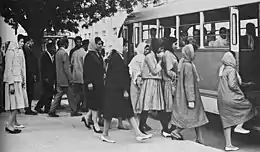
-_Menschen_-_Annemarie_Schwarzenbach_-_SLA-Schwarzenbach-A-5-20-203.jpg.webp)
Afghanistan's population is roughly 34 million.[15] Of these, 15 million are male and 14.2 million are female.[16] About 22% of the Afghan people are urbanite and the remaining 78% live in rural areas.[17] As part of local tradition, most women are married soon after completing high school. Many live as housewives for the remainder of their lives.[18]
Amanullah Khan
Some Rulers of Afghanistan have consistently attempted to increase women's freedom. For the most part, these attempts were unsuccessful. However, there were a few leaders who were able to make some significant changes. The first of them was King Amanullah, who ruled from 1919 to 1929 and made some of the more noteworthy changes in an attempt to unify as well as modernize the country.[19] He, along with other rulers following him, promoted freedom for women in the public sphere in order to lessen the control that patriarchal families exerted over women. King Amanullah stressed the importance of female education. Along with encouraging families to send their daughters to school, he promoted the unveiling of women and persuaded them to adopt a more western style of dress.[20] In 1921, he created a law that abolished forced marriage, child marriage, and bride price, and put restrictions on polygamy, a common practice among households in the Afghanistan region.[20] Over time these restrictions became nearly impossible to enforce.
Modern social reform for Afghan women began when Queen Soraya, wife of King Amanullah, made rapid reforms to improve women's lives and their position in the family, marriage, education and professional life.[21] She founded the first women's magazine as well as the first women's organization, the Anjuman-i Himayat-i-Niswan. Appearing in public with her husband, she set an example to abolish the gender segregation and famously removed her veil in public, and her example was followed by others.[21] She was the only woman to appear on the list of rulers in Afghanistan and was credited with having been one of the first and most powerful Afghan and Muslim female activists.
Queen Soraya, along with her husband's, advocacy of social reforms for women led to a protest and contributed to the ultimate demise of her and her husband's reign in 1929.[22] King Amanullah Khan's deposition caused a severe backlash, and his successor reinstated the veil [23] and repelled the reforms in women's rights, reinforcing purdah.[21]
Mohammed Zahir Shah
Successors Mohammed Nadir Shah and Mohammed Zahir Shah acted more cautiously, but nevertheless worked for the moderate and steady improvement of women's rights[24] After the Second World War modernization reforms were seen as necessary by the government, which resulted in the resurrection of the women's movement. In 1946, the government-supported Women's Welfare Association was founded with Queen Humaira Begum as its head,[23] and in 1950–51, women students were accepted at the Kabul University.[21]
Following the election of Mohammed Daoud Khan as Prime Minister in 1953, social reforms giving women a more public presence were encouraged.[25][26] One of his aims was to break free from the ultra-conservative, Islamist tradition of treating women as second-class citizens. During his time, he made significant advances towards modernization.[27]
The Prime Minister prepared women's emancipation carefully and gradually. He began by introducing women workers at the Radio Kabul in 1957, by sending women delegates to the Asian Women's Conference in Kairo, and by employing forty girls to the government pottery factory in 1958.[28] When this was met with no riots, the government decided it was time for the very controversial step of unveiling.[28] On August 1959, on the second day of the festival of Jeshyn, Queen Humaira Begum and Princess Bilqis appeared in the royal box at the military parade unveiled, alongside the Prime Minister's wife, Zamina Begum.[28] A group of Islamic clerics sent a letter of protest to the Prime minister to protest and demand that the words of sharia be respected.[28] The Prime minister answered by inviting them to the capital and present proof to him that the holy scripture indeed demanded the chadri.[28] When the clerics could not find such a passage, the Prime Minister declared that the female members of the Royal Family would no longer were veils because the Islamic law did not demand it.[28] While the chadri was never banned, the example of the Queen and the Prime Minister's wife was followed by the wives and daughters of government officials as well as by other urban women of the upper class and middle class, with Kubra Noorzai and Masuma Esmati-Wardak known as the first commoner pioneers.[28]
Small numbers of women were able to hold jobs as scientists, teachers, doctors, and civil servants, and they had a considerable amount of freedom with significant educational opportunities.[29]
The 1964 Constitution of Afghanistan granted women equal rights including universal suffrage and the right to run for office.[30] However, the majority of women continued to be excluded from these opportunities, as these reforms had little effect outside of cities.[24] The countryside was a deeply patriarchal, tribal society.[31]
In 1977, the Revolutionary Association of the Women of Afghanistan (RAWA) was founded by Meena Keshwar Kamal. Her office was moved to Quetta in Pakistan, where she was assassinated in 1987.[32] RAWA still operates in the Afghanistan-Pakistan region.[33]
Afghan Women's Council
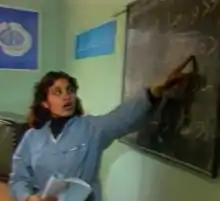
The Afghan Women's Council (AWC) was an organization under the Democratic Republic of Afghanistan (1978–87) and the Republic of Afghanistan (between 1987 and 1992). Until 1989, the AWC was led by Masuma Esmati-Wardak and run by a staff of eight women.[34] In 1978, the government, led by Nur Muhammad Taraki, gave equal rights to women. This gave them the theoretical ability to choose their husbands and careers.[35] The AWC had around 150,000 members and offices in nearly all the provinces.[34] The AWC provided social services to women in Afghanistan, in the fought against illiteracy and provided vocational training in the secretarial, hairdressing and manufacturing fields. Many feared the sacrificing of the AWC in the national reconciliation talks which started in 1987.[35] It is claimed that in 1991 around seven thousand women were in the institution of higher education and around 230,000 girls studying in schools around Afghanistan. There were around 190 female professors and 22,000 female teachers.[35]
Mujahideen and Taliban era
In 1992, the government under Mohammad Najibullah transitioned to the Islamic State of Afghanistan.[36] War in Afghanistan continued into a new phase when Gulbuddin Hekmatyar started a bombardment campaign against the Islamic State in Kabul.[37]
The restrictions imposed when the Islamic State was established were "the ban of alcohol and the enforcement of a sometimes-purely-symbolic veil for women".[38] Women, however, remained in the workplace and the liberal provisions of the 1964 constitution were largely upheld. Women began to be more restricted after Hekmatyar was integrated into the Islamic State as Afghan Prime Minister in 1996. He demanded for women who appeared on TV to be fired. During the violent four-year civil war a number of women had been kidnapped and some of them raped. During this period the Taliban made their way to take control of Kabul.[19]

Like their leader Mullah Omar, most Taliban soldiers were poor villagers educated in Wahhabi schools in neighboring Pakistan. Pakistani Pashtuns also joined the group. The Taliban declared that women were forbidden to go to work and that they were not to leave their homes unless accompanied by a male family member. When they did go out, they were required to wear an all-covering burqa. Women were denied formal education[20] and usually forced to stay at home.
During the Taliban's five-year rule, women in Afghanistan were essentially put under house arrest, and often forced to paint their windows over so that no one could see in or out.[29] Some women who once held respectable positions were forced to wander the streets in their burqas selling everything they owned or begging in order to survive. The United Nations refused to recognize the Taliban government, with the United States imposing heavy sanctions, leading to extreme economic hardship.
Because most teachers had been women before the Taliban regime, the new restrictions on women's employment created a huge lack of teachers, which put an immense strain on the education of both boys and girls. Although women were banned from most jobs, including teaching, some women in the medical field were allowed to continue working.[29] This is because the Taliban required that women could be treated only by female physicians.[20]
Several Taliban and Al-Qaeda commanders engaged in human trafficking, abducting women and selling them into forced prostitution and slavery in Pakistan.[39] Time Magazine writes: "The Taliban often argued that the brutal restrictions they placed on women were actually a way of revering and protecting the opposite sex. The behavior of the Taliban during the six years they expanded their rule in Afghanistan made a mockery of that claim."[39]
21st century
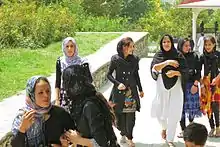

In late 2001, a new government under Hamid Karzai was formed by the United Nations, which includes women like in pre-1990s Afghanistan.[11] Under the new constitution of 2004, 27 percent of the 250 seats in the House of the People are reserved for women.[40]
In March 2012, President Karzai endorsed a "code of conduct" which was issued by the Ulema Council. Some of the rules state that "women should not travel without a male guardian and should not mingle with strange men in places such as schools, markets and offices." Karzai said that the rules were in line with Islamic law and that the code of conduct was written in consultation with Afghan women's group."[41] Rights organizations and women activists said that by endorsing this code of conduct, Karzai is endangering "hard-won progress in women's right since the Taliban fell from power in 2001.[42] The BBC reported that a number of women have reacted to the endorsement with humor.[43]
The overall situation for Afghan women has improved in the last decade, particularly in the major urban areas, but those living in rural parts of the country still face many problems. In 2013, a female Indian author Sushmita Banerjee was killed in Paktika province by militants for allegedly defying Taliban diktats. She was married to an Afghan businessman and had recently relocated to Afghanistan. Earlier she had escaped two instances of execution by the Taliban in 1995 and later fled to India. Her account of the escape became a Bollywood film, Escape from Taliban.[44]
A 2011 government report found that 25 percent of the women and girls diagnosed with fistula were younger than 16 when they married.[45][46] In 2013, the United Nations published statistics showing a 20% increase in violence against women, often due to domestic violence being justified by conservative religion and culture. In February 2014, Afghanistan passed a law that includes a provision that limits the ability of government to compel some family members to be witnesses to domestic violence. Human Rights Watch described the implementation of the 2009 Law on the Elimination of Violence Against Women as "poor," noting that some cases are ignored.
Under Afghan law, females all across the country are permitted to drive vehicles.[47][48][49][50][51][7][52] They are also permitted to participate in certain international events such as Olympic Games and robot competitions.[53] Human rights organizations, including Human Rights Watch[54][55] and the United States Commission on International Religious Freedom[56] have expressed concern at women's rights in the country. Georgetown Institute for Women, Peace and Security ranks Afghanistan as one of the worst countries for women.[57]
According to the new law signed by Ashraf Ghani president of Afghanistan, Afghan women were allowed to include their names on their children’s birth certificates and identification cards. This law served as a major victory for Afghan women’s rights activists, including Laleh Osmany, who campaigned under the social media hashtag #WhereIsMyName, for several years for both the parents’ names to be included.[58]
Violence against Afghan women
Many women in Afghanistan experience some form of abuse. The World Health Organisation in 2015 reported that 90% of women in Afghanistan had experienced at least one form of domestic violence. Violence against women is widely tolerated by the community, and widely practiced in Afghanistan.[59] Violence against women in Afghanistan ranges from verbal abuse and psychological abuse to physical abuse and unlawful killing.
From infancy girls and women are under the authority of the father or husband.[59] They have restricted freedom of movement from their childhoods and they have restrictions on their choice of husband. Women and girls are deprived of education and economic liberty. They have limited possibilities to assert their economic and social independence in their family pre-marriage and in their relationship post-marriage. Most married Afghan females are faced with the stark reality of enduring abuse.[59] Should they try to extricate themselves from the situation of abuse, they invariably face social stigma, social isolation, persecution by authorities for leaving the home and honour killing by a relative.[59]
Customs and traditions influenced by centuries-old patriarchal rules prevail, the issue of violence against women becomes pronounced. The high levels of illiteracy rates among the population further perpetuates the problem. A number of women across Afghanistan believe that it is acceptable for their husbands to abuse them. Reversing this general acceptance of abuse was one of the main reasons behind the creation of the EVAW.[60]
In 2009, the Elimination of Violence Against Women (EVAW) was signed into law. The EVAW was the creation of multiple organizations as well as prominent women's rights activists in Kabul (namely UNIFEM, Rights & Democracy, Afghan Women's Network, the Women's Commission in the Parliament and the Afghan Ministry of Women's Affairs.[61]
In March 2015 Farkhunda Malikzada, a 27-year-old Afghan woman was publicly beaten and slain by an angry mob of radical Muslims in Kabul on a false accusation of Quran desecration.[62][63][64] A number of prominent public officials turned to Facebook immediately after the death to endorse the heartless lynching.[65] It was later revealed that she did not burn the Quran.[66]
In 2018, Amnesty International reported that violence against women was perpetrated by both state and non-state actors.[67]
In April 2020, HRW reported that women with disabilities in Afghanistan face all forms of discrimination and sexual harassment while accessing government assistance, health care and schools. The report also detailed everyday barriers that women and girls face in one of the world’s poorest countries.[68]
On August 14, 2020, Fawzia Koofi, member of Afghanistan’s peace negotiating team, got wounded in an assassination attempt near the capital, Kabul, while returning from a visit to the northern province of Parwan. Fawzia Koofi is a part of a 21-member team charged with representing the Afghan government in upcoming peace talks with the Taliban.[69]
A 33-year-old Afghan women was attacked by three people on her way from work to home. She was shot and stabbed in her eyes with a knife. The woman survived, but lost her eyesight. Taliban denied the allegations and said that the attack was carried out on her father’s order, as he vehemently opposed her working outside of home.[70]
Honor killing
In 2012, Afghanistan recorded 240 cases of honor killings. Of the reported honor killings, 21% were committed by the victims' husbands, 7% by their brothers, 4% by their fathers, and the rest by other relatives.[71]
In May 2017, United Nations Assistance Mission in Afghanistan concluded that the vast majority of perpetrators of honor killings were not punished.[72]
Politics and workforce
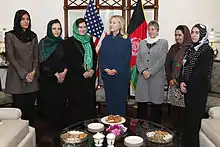
A large number of Afghan women serve as members of parliament.[3] Some of these included Shukria Barakzai, Fauzia Gailani, Nilofar Ibrahimi,[73] Fauzia Koofi, and Malalai Joya. Several women also took positions as ministers, including Suhaila Seddiqi, Sima Samar, Husn Banu Ghazanfar, and Suraya Dalil. Habiba Sarabi became the first female governor in Afghanistan. She also served as Minister of Women's Affairs. Azra Jafari became the first female mayor of Nili, the capital of Daykundi Province. As of December 2018, Roya Rahmani is the first-ever female Afghan ambassador to the United States. In September 2020, Afghanistan has secured a seat on the U.N. Commission on the Status of Women for the first time, an achievement that is seen as a “sign of progress for a country once notorious for the oppression of women”.[74]

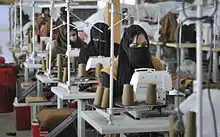


The Afghan National Security Forces (ANSF), which includes the Afghan National Police, have a growing number of female officers. One of the Afghan National Army Brigadier generals is Khatol Mohammadzai. In 2012, Niloofar Rahmani became the first female pilot in the Afghan Air Force pilot training program to fly solo in a fixed-wing aircraft,[75] following the footsteps of Colonel Latifa Nabizada, the first Afghan female pilot ever to fly a military helicopter. Other notable Afghan women include Roya Mahboob, Aziza Siddiqui, Mary Akrami, Suraya Pakzad, Wazhma Frogh, Shukria Asil, Shafiqa Quraishi, Maria Bashir, Maryam Durani, Malalai Bahaduri, and Nasrin Oryakhil.
The most popular traditional work for women in Afghanistan is tailoring, and a large percentage of the population are professional tailors working from home.[76] Since the fall of the Taliban, women have returned to work in Afghanistan. Some became entrepreneurs by starting businesses. For example, Meena Rahmani became the first woman in Afghanistan to open a bowling center in Kabul.[77] Many others are employed by companies and small businesses. Some engaged in singing, acting, and news broadcasting.[4] In 2015, a 17-year-old Negin Khpolwak became Afghanistan's first female music conductor.[78]
In 2014, women made up 16.1% of the labor force in Afghanistan.[79] Because the nation has a struggling economy overwhelmed with massive unemployment, women often cannot find work where they receive sufficient pay.[20] One area of the economy where women do play a significant role is in agriculture. Of the number of Afghans employed in the agriculture field or similar occupations, about 30 percent of them are women.[20] In some areas in Afghanistan, women may spend as much time working on the land as men do, but still often earn three times less than men in wages.[20]
In terms of percentage, women rank high in the fields of medicine and media, and are slowly working their way into the field of justice. Because women are still highly encouraged to consult a female physician when they go to the hospital, nearly fifty percent of all Afghans in the medical profession are women.[20] The number of women having professions in the media is also rising. It was reported in 2008 that nearly a dozen of television stations had all-female anchors as well as female producers.[20] As women are given more opportunities in education and the workforce, more of them are turning towards careers in medicine, media, and justice.
However, even the women that are given the opportunity to have careers have to struggle to balance their home life with their work life, as household tasks are seen as primarily female duties. Since the Afghan economy is weak, very few women can afford to hire domestic helpers, so they are forced to take care of all the household work primarily on their own.[20] Those who choose to work must labour twice as hard because they are essentially holding two jobs.
Education


Education in Afghanistan has gradually improved in the last decade but much more has to be done to bring it to the international standard.[5][6][8][9][10] The literacy rate for females is merely 24.2%.[15] There are around 9 million students in the country. Of this, about 60% are males and 40% females. Over 174,000 students are enrolled in different universities around the country. About 21% of these are females.[80]

In the early twentieth century, education for women was extremely rare due to the lack of schools for girls. Occasionally girls were able to receive an education on the primary level but they never moved past the secondary level.[20] During Zahir Shah's reign (1933–1973) education for women became a priority and young girls began being sent to schools. At these schools, girls were taught discipline, new technologies, ideas, and socialization in society.[20]
Kabul University was opened to girls in 1947 and by 1973 there were an estimated 150,000 girls in schools across Afghanistan. Unfortunately, marriage at a young age added to the high drop out rate but more and more girls were entering professions that were once viewed as only being for men.[20] Women were being given new opportunities to earn better lives for both themselves and their families. However, after the civil war and the takeover by the Taliban, women were stripped of these opportunities and sent back to lives where they were to stay at home and be controlled by their husbands and fathers.
During the Taliban regime, many women who had previously been teachers began secretly giving an education to young girls (as well as some boys) in their neighborhoods, teaching from ten to sixty children at a time.[29] The homes of these women became community homes for students, and were entirely financed and managed by women. News about these secret schools spread through word of mouth from woman to woman.[29]
Each day young girls would hide all their school supplies, such as books, notebooks and pencils, underneath their burqas to go to school. At these schools, young females were taught basic literary skills, numeracy skills, and various other subjects such as biology, chemistry, English, Quranic Studies, cooking, sewing, and knitting. Many women involved in teaching were caught by the Taliban and persecuted, jailed, and tortured.[29]
The Taliban are still opposed to education for Afghan boys and girls. They are burning down schools, killing students and teachers by all kinds of means, including chemical warfare. For example, in June 2012, fifteen suspects were detained by Afghanistan's National Directorate of Security (NDS) "in connection with the serial anti-school attacks in northern Afghanistan." The NDS believes that Pakistan's Inter-Services Intelligence was behind the idea.[81] During the same period, Pakistan has been refusing to deliver Afghan bound school text books.[82]
In 2015 the Kabul University began the first master's degree course in gender and women's studies in Afghanistan.[83]
Afghan women obtain education in Kazakhstan within the Kazakh-Afghan state educational programme sponsored by the Republic of Kazakhstan. Kazakhstan attaches great importance to empowering women and strengthening stability in Afghanistan.[84] In September 2018, Kazakhstan reached an agreement with the European Union that the EU would contribute two million euros to train and educate Afghan women in Kazakhstan.[85]
In October 2019, Kazakhstan, the EU and the UNDP launched an education programme to train and educate several dozen Afghan women in Kazakh universities over the next five years. As of 2019, almost 900 graduates of Kazakhstan’s programme serve in top positions in the Afghan president’s office, government ministries, the border guards and police, while others work as respected doctors, engineers and journalists.[86]
Sport

In the last decade, Afghan women have participated in various types of sports including futsal, football, and basketball. In 2015 Afghanistan held its first marathon; among those who ran the entire marathon was one woman, Zainab, age 25, who thus became the first Afghan woman to run in a marathon within her own country.[87] this is also followed by soccer and touch with the allowance of cricket.
Marriage and parenting
-_Menschen_-_Annemarie_Schwarzenbach_-_SLA-Schwarzenbach-A-5-20-013.jpg.webp)

Marriages in Afghanistan are usually in accordance with Islam and Afghanistan culture. The legal age for marriage in Afghanistan is 16.[88] Afghans marry each other based on religious sect, ethnicity, and tribal association. It is rare to see a marriage between a Sunni Pashtun and a Shia Hazara. The nation is a patriarchal society where it is commonly believed that elder men are entitled to make decisions for their families.[89] A man can divorce without needing his wife's agreement, whereas the opposite is not true.[90]
The country has a high total fertility rate, at 5.33 children born/woman as of 2015.[15] Contraception use is low: 21.2% of women, as of 2010/11.[15]
Arranged marriage is usually the only way in Afghanistan. After a marriage is arranged, the two families sign a contract that both parties are socially and culturally obligated to honor. It is common among low-income families for the groom to pay a bride price to the bride's family. The price is negotiated among the parents only. The bride price is viewed as compensation for the money that the bride's family has had to spend on her care and upbringing.[89]
Forced marriage is also reported in Afghanistan. In almost 50% of cases, the bride is younger than 18 and in 15% of marriages, the bride is younger than 15. Sometimes women resort to suicide to escape these marriages.[91]
In certain areas females are sometimes bartered in a method of dispute resolution called baad that proponents say helps avoid enmity and violence between families, although the females themselves are sometimes subject to considerable violence both before and after marrying into a family through baad. The practice of baad is considered illegal in Afghanistan.[92]
Under the Afghan law, "if a woman seeks a divorce then she has to have the approval of her husband and needs witnesses who can testify in court that the divorce is justified."[90] The first occurrence of a woman divorcing a man in Afghanistan was the divorce initiated by Rora Asim Khan, who divorced her husband in 1927.[93] This was described as unique at the time it occurred, but this was an exception, as Rora Asim Khan was a foreign citizen, who obtained her divorce by assistance from the German embassy.[93]
While it is legal for male citizens to marry foreign non-Muslims, it is illegal for female citizens to do so, and Afghan law considers all Afghan citizens Muslim.[94]
Up until September 17, 2020 Afghan law dictated that only the father's name should be recorded on ID cards. President Ashraf Ghani signed into law an amendment long sought by women's rights campaigners since a campaign launched three years ago under the hashtag #WhereIsMyName which garnered high-profile support from celebrities and members of parliament.[95]
Gallery
 Mother's Day event in Afghanistan
Mother's Day event in Afghanistan A young woman drawing water
A young woman drawing water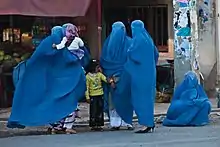
 Old woman in Herat
Old woman in Herat.jpg.webp) An Afghan girl in Oruzgan Province
An Afghan girl in Oruzgan Province.jpg.webp) Girls enjoying a meal in Chaghcharan on Orphanage Day
Girls enjoying a meal in Chaghcharan on Orphanage Day_(2).jpg.webp) Woman wearing Burqa near Balkh
Woman wearing Burqa near Balkh Girl from Kandahar Province
Girl from Kandahar Province.jpg.webp) An Afghan girl receiving treatment from an American medic in Oruzgan Province
An Afghan girl receiving treatment from an American medic in Oruzgan Province.jpg.webp) A mother with her children in a village near Charghcharan
A mother with her children in a village near Charghcharan
See also
- Gender roles in Afghanistan
- Access for Afghan Women Act
- Prostitution in Afghanistan
- Women in agriculture in Afghanistan
- Humira Saqib
Organisations:
- Women for Afghan Women
- Revolutionary Association of the Women of Afghanistan
- Afghan Women's Network
- Afghan Women's Council
- Afghan Women's Business Federation
- Afghanistan women's national football team
- Afghanistan national women's cricket team
General:
References
- "Labour force participation rate, female".
- "An introduction to the constitutional law of Afghanistan" (PDF). Retrieved 5 December 2019.
- "Afghan forces could turn guns on Kabul without US air support, cash and troops, among other warnings". military times. 29 March 2019. Retrieved 29 March 2019.
Of 320 parliamentary seats, 63 are held by women; 68,000 Afghan women are school and university instructors. And another 6,000 serve as judges, prosecutors, defense attorneys, police and soldiers, according to SIGAR’s report.
- "Afghan Girl Wins Reality Show For The First Time". TOLOnews. 2 April 2019. Retrieved 18 April 2019.
- Kabul's American university students defiant despite violence. Al Jazeera English. 16 July 2017. Retrieved 18 April 2019.
- Gender and Women's Studies at Kabul University: A Step Towards Addressing the Gender Gap. UNDP Afghanistan. 11 July 2016. Retrieved 18 April 2019.
- For Afghan women, driving a car brings both fear and freedom. AFP news agency. 7 November 2015. Retrieved 18 April 2019.
- Inside Afghanistan's First Boarding School for Girls. National Geographic. 26 December 2014. Retrieved 18 April 2019.
- An Introduction: The American University of Afghanistan. American University of Afghanistan (AUAF). 9 November 2014. Retrieved 18 April 2019.
- Meet a New Generation of Women in Kabul. National Geographic. 21 October 2014. Retrieved 18 April 2019.
- "Women's Rights Our Red Line In Peace Process: Ghani". TOLOnews. 12 April 2019. Retrieved 12 April 2019.
- Sultan, Masuda. "Afghan Constitution a Partial Victory for Women". Women's eNews. Retrieved 5 December 2019.
- "Women in Afghanistan - Norwegian Afghanistan Committee". www.afghanistan.no. Retrieved 26 August 2019.
- By Farrah Azeem Khan (5 December 2018). "2018 Survey of Afghan People Shows Women's Rights are Complicated". Asia Foundation. Retrieved 6 April 2019.
- "Afghanistan". The World Factbook. www.cia.gov. Retrieved 1 December 2017.
- "Afghan Population 29.2 Million | Pajhwok Afghan News". www.pajhwok.com. Retrieved 12 January 2019.
- Mohammad Jawad Sharifzada, ed. (20 November 2011). "Afghanistan's population reaches 26m". Pajhwok Afghan News. Retrieved 5 December 2011.
- "Working with Gender in Rural Afghanistan: Experiences from Norwegian-funded NGO projects" (PDF). www.cmi.no. September 2014. Retrieved 12 January 2019.
- Keddie, Nikki R. (2007). Women in the Middle East. Princeton University Press. ISBN 978-0-691-12863-4.
- Skaine, Rosemarie (23 September 2008). Women of Afghanistan In The Post-Taliban Era: How Lives Have Changed and Where They Stand Today. McFarland. ISBN 978-0-7864-3792-4.
- Julie Billaud: Kabul Carnival: Gender Politics in Postwar Afghanistan
- "A History of Women in Afghanistan: Lessons Learnt for the Future" (PDF). Dr. Huma Ahmed-Ghosh. Aletta, Institute for Women's History. May 2003. Retrieved 2 December 2010.
- Robin Morgan: Sisterhood is Global: The International Women's Movement Anthology
- Children of Afghanistan: The Path to Peace by Jennifer Heath, Ashraf Zahedi
- "Daoud Khan, Muhammad - Oxford Islamic Studies Online". www.oxfordislamicstudies.com. Retrieved 12 January 2019.
- "A Historical Timeline of Afghanistan". PBS NewsHour. 4 May 2011. Retrieved 12 January 2019.
- Armstrong, Sally (6 January 2003). Veiled Threat: The Hidden Power of the Women of Afghanistan. Seal Press. ISBN 978-1-56858-252-8.
- Tamim Ansary (2012) Games without Rules: The Often-Interrupted History of Afghanistan
- Rostami-Povey, Elaheh (16 October 2007). Afghan Women: Identity and Invasion. Zed Books. ISBN 978-1-84277-856-2.
- "Timeline of Women's Rights in Afghanistan | Women, War and Peace | PBS". Women, War and Peace. 25 October 2011. Retrieved 12 January 2019.
- Gopal, Anand (14 May 2009). "What You Should Know About Women's Rights in Afghanistan". Huffington Post. Retrieved 12 January 2019.
- Toynbee, Polly (28 September 2001). "Behind the burka". The Guardian.
- "About RAWA". Revolutionary Association of the Women of Afghanistan.
- Mary Ann Tétreault (1994). Women and revolution in Africa, Asia, and the New World. ISBN 9781570030161. Retrieved 24 March 2009.
- Lawrence Kaplan. Fundamentalism in comparative perspective. Univ of Massachusetts Press. p. 144. Retrieved 24 March 2009.
- Amin Saikal (27 August 2004). Modern Afghanistan: A History of Struggle and Survival (2006 1st ed.). I.B. Tauris & Co Ltd., London New York. pp. 214–215. ISBN 1-85043-437-9.
- Nikki R. Keddie. Women in the Middle East: Past and Present. p. 118.
- William Maley. Fundamentalism Reborn?: Afghanistan and the Taliban. p. 207.
- "Lifting The Veil On Taliban Sex Slavery". Time Magazine. 10 February 2002.
- "'It is time': Afghanistan's female candidates promise change". www.aljazeera.com. Retrieved 26 August 2019.
- "Hamid Karzai backs clerics' move to limit Afghan women's rights". The Guardian. London. 6 March 2012.
- "Hamid Karzai under fire on Afghan women's rights". The Daily Telegraph. London. 9 March 2012.
- Kitsos, Konstantinos. "Women's Rights In Afghanistan". Cite journal requires
|journal=(help) - "Indian Author Sushmita Banerjee killed by Taliban in Afghanistan". Retrieved 5 September 2013.
- "Afghanistan: Child Marriage, Domestic Violence Harm Progress". Human Rights Watch. 4 September 2013.
- "Escaping Child Marriage in Afghanistan". UNFPA. 4 October 2012.
- "In a first, 40 women issued driving licenses in Helmand". Pajhwok Afghan News. 28 March 2019. Retrieved 18 April 2019.
- "Afghanistan's pioneering women get behind the wheel to drive through stigma". Al Jazeera. 27 September 2018. Retrieved 18 April 2019.
- "More Women Get Behind the Wheel in Northern Afghanistan". Voice of America. 23 July 2018. Retrieved 18 April 2019.
- "Despite The Backlash, Women Take The Wheel In Afghanistan". HuffPost. 1 September 2016. Retrieved 18 April 2019.
- "Number of female drivers doubles in Herat". Pajhwok Afghan News. 30 November 2016. Retrieved 18 April 2019.
- "Afghan woman pushes for rights from behind the wheel". Retuers. 15 May 2012. Retrieved 18 April 2019.
- "How I became captain of the winning all-girls Afghan robotics team". CNN. 11 October 2018. Retrieved 18 April 2019.
- "World Report 2014: Afghanistan". Human Rights Watch.
- "World Report 2015: Afghanistan". Human Rights Watch.
- "USCIRF Annual Report 2014 – Tier 2: Afghanistan". United States Commission on International Religious Freedom. 30 April 2014.
- "Index Country Rankings" (PDF). Georgetown Institute for Women, Peace and Security. Retrieved 30 November 2017.
- "Afghan Women Win Fight for Their Own Identity". Human Rights Watch. Retrieved 18 September 2020.
- Denise Kindschi Gosselin, Heavy Hands: An introduction to the Crimes of Family Violence, (Pearson, 2010) 7
- "OHCHR | Statement by the Special Rapporteur on violence against women finalizes country mission to Afghanistan and calls for sustainable measures to address the causes and consequences of violence against women, including at the individual, institutional and structural level". www.ohchr.org. Retrieved 28 March 2019.
- Koofi, Fawzia. "It's Time to Act for Afghan Women: Pass EVAW". Foreign Policy. Retrieved 26 August 2019.
- "Four Afghan Men Held in Acid Attack on Family". ALISSA J. RUBIN and ROD NORDLAND. The New York Times. 10 December 2011.
- "Family of Afghan woman lynched by mob demands justice". Al Jazeera. 2 April 2015.
- The Killing of Farkhunda. New York Times.
- Shalizi, Hamid; Donati, Jessica (20 March 2015). "Afghan cleric and others defend lynching of woman in Kabul". Reuters. Retrieved 9 August 2015.
- Moore, Jack (23 March 2015). "Afghans Protest Brutal Mob Killing of 'Innocent' Woman". Newsweek. Newsweek. Retrieved 29 March 2015.
- "Afghanistan 2017/2018". www.amnesty.org. Retrieved 5 January 2019.
- "Afghanistan: Women with Disabilities Face Systemic Abuse". Human Rights Watch. Retrieved 28 April 2020.
- "Female Afghan peace negotiator wounded in assassination bid". The Guardian. Retrieved 16 August 2020.
- "Afghan woman shot, blinded, for getting a job". Reuters. Retrieved 10 November 2020.
- "240 cases of honor killing recorded in Afghanistan". khaama.com. 9 June 2013. Retrieved 23 December 2013.
- Injustice and Impunity Mediation of Criminal Offences of Violence against Women. Kabul: United Nations Assistance Mission in Afghanistan. May 2018. p. 8.
- US Embassy Kabul Afghanistan (20 March 2011). "Untitled | Flickr - Photo Sharing!". Secure.flickr.com. Retrieved 10 November 2015.
- Saif, Shadi Khan (24 September 2020). "Afghanistan's first female U.N. envoy warns over women's rights". Reuters.
- "U.S. training helps Afghan female pilot go solo". Air Force Times. 22 October 2012. Retrieved 5 January 2013.
She is one of five pilot trainees in UPT Class 12-03 — the class has months of training ahead prior to receiving their wings and will graduate next summer. She has received accolades from the Afghan public and is viewed as a positive role model for Afghan females.
- Afghan women struggle to make ends meet as tailors
- In Kabul, a bowling center offers respite from war
- "Afghanistan's first female conductor". BBC.com. 10 November 2015. Retrieved 10 November 2015.
- "Labor force, female (% of total labor force) | Data". data.worldbank.org. Retrieved 26 August 2019.
- "Education". United States Agency for International Development (USAID). Retrieved 26 May 2017.
- Zarghona Salehi, ed. (6 June 2012). "15 held for poisoning schoolgirls: Mashal". Pajhwok Afghan News.
- Zarghona Salehi, ed. (12 May 2012). "Afghan students to Pakistan: Release our books". Pajhwok Afghan News.
- FaithWorld (26 October 2015). "Kabul University unlikely host for first Afghan women's studies programme". Blogs.reuters.com. Retrieved 2 November 2015.
- "Kazakhstan's assistance to Afghanistan helps strengthen regional and global security, diplomat says". astanatimes.com.
- "Video address by HRVP Federica Mogherini at the Astana Conference on Empowering Women in Afghanistan". eeas.europa.eu.
- "EU, UNDP and Kazakhstan launch education programme to train Afghan women". astanatimes.com.
- "Feminist Daily News 10/29/2015: Afghan Woman Runs in Country's First Marathon". Feminist.org. 29 October 2015. Retrieved 2 November 2015.
- "Afghanistan Has a Tougher Law on Child Marriage than Florida". Human Rights Watch. 20 October 2017. Retrieved 31 March 2019.
In Afghanistan girls can marry at 16, or at 15 with permission from their father or a judge.
- Hafizullah, Emadi (30 August 2002). Repression, Resistance, and Women in Afghanistan. Praeger. ISBN 978-0-275-97671-2.
- "Divorce, suicide; 'Hell' in Herat". Golnar Motevalli. Revolutionary Association of the Women of Afghanistan. 23 July 2009.
- "Afghan women escape marriage through suicide | DW | 18.04.2013". DW.COM. Retrieved 5 January 2019.
- "Afghan Girls Suffer for Sins of Male Relatives". Wahida Paykan. Institute for War and Peace Reporting. 26 March 2009. Retrieved 26 May 2017.
- Rora Asim Khan (Aurora Nilsson): Anders Forsberg och Peter Hjukström: Flykten från harem, Nykopia, Stockholm 1998. ISBN 91-86936-01-8.
- "U.S. Embassy in Afghanistan". U.S. Embassy in Afghanistan. Retrieved 19 March 2019.
- "Afghan mothers' names added to children's ID cards". BBC News. 18 September 2020.
External links
| Wikimedia Commons has media related to Women of Afghanistan. |
- DEBATE: Afghan Women’s Role In Peace Process on YouTube, April 10, 2019, TOLOnews.
- Army offers rare career opportunities for Afghan women on YouTube, March 14, 2019, France 24 English.
- Afghan peace talks: What do Afghan women think? on YouTube, February 25, 2019, BBC News.
- Taliban Talks: Afghan women fear losing hard-won freedoms on YouTube, February 8, 2019, France 24 English.
- DNA Special: 20 Afghan women army officers arrive in India on YouTube, December 12, 2017, Zee News.
- A Place At The Table: Safeguarding Women's Rights in Afghanistan
- Women, Afghan Law, and Sharia
- Afghan Khaal or Facial tattoo for women in afghanistan (Khaal)
